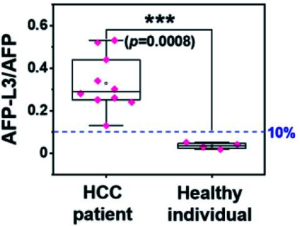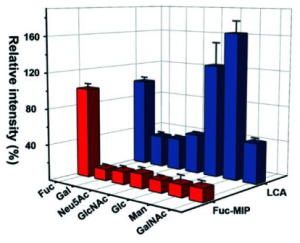A group from State Key Laboratory of Analytical Chemistry for Life Science, School of Chemistry and Chemical Engineering, Nanjing University, Nanjing, China has reported diagnosis of hepatocellular carcinoma (HCC) using AFP-L3 as the marker and using new probes made by molecular imprinting of the marker.
https://www.ncbi.nlm.nih.gov/pmc/articles/PMC9020343/
A new strategy called triple MIP-based PISA (triMIP-PISA) was developed for precise disease diagnosis by detecting changes of glycosylation of glycoprotein disease biomarkers. This method benefits greatly from the excellent protein-recognizing properties of MIPs that approach those of monoclonal antibodies, as well as the excellent monosaccharide-recognizing properties of MIPs, outperforming lectins.
This strategy utilized triple recognition of the glycoprotein biomarker by three different types of Molecular Imprinted Polymers(MIPs) integrated with plasmonic detection.
An N-terminal epitope-imprinted substrate was used to specifically extract the target glycoprotein from clinical samples, then the captured target molecules were labelled with C-terminal epitope-imprinted nanotags encapsulated with Raman reporter 1, while the fucosylated glycans of the glycoprotein were labelled with fucose (Fuc)-imprinted nanotags encapsulated with Raman reporter 2, which has characteristic Raman peaks distinct from those of reporter 1. Sandwich-like immunocomplexes formed on the substrate were subject to plasmonic detection.
In this report, this method was applied to HCC diagnosis using AFP-L3 as the marker. Raman signal generated by reporter 1-containing nanotags reports the total AFP level, while that by the reporter 2-containing nanotags reports the level of fucosylated glycans of AFP (also referred to as L3). Thus, the relative expression level of fucosylated glycoforms over the total level of AFP in human serum (AFP-L3/AFP) can function as a reliable and specific indicator for HCC patients. The Kd value of the AFP N-terminal epitope imprinted substrate could reach 10−9 M level, which is much smaller than that of LCA lectin.


